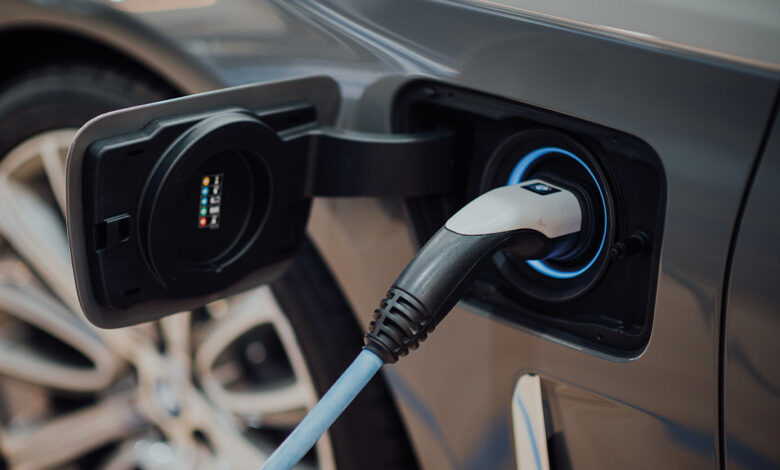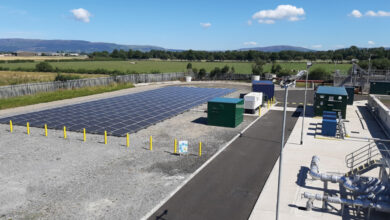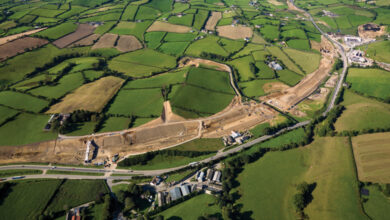Charging infrastructure for decarbonised transport

With Northern Ireland projected to “fall well short” of net zero emissions by 2050 without radical action, David Whelan looks at the new Electric Vehicle Infrastructure Action Plan’s role in decarbonising private transport.
Worryingly, the Climate Change Committee’s (CCC) critical assessment of Northern Ireland’s progress towards net zero was not based on current trajectory, but rather on the assumption that Northern Ireland will undertake an “extremely challenging” balanced pathway.
Assumed in the balanced pathway are several significant transitions beyond Northern Ireland’s current scenario. These include decarbonisation of electricity generation, an almost one-third reduction of Northern Ireland’s livestock numbers, a significant increase in peatland restoration and afforestation, and, that all new car and van sales be zero-emissions by the first half of the 2030s.
That decarbonisation of the private vehicle fleet will require a radical shift from the current scenario in the region. At end of June 2022, there were 1.25 million registered vehicles in Northern Ireland, of which, only 0.7 per cent were Ultra-Low Emission Vehicles (ULEVs). Of these vehicles, close to half were plug-in hybrids.
The UK Government has set out plans to end the sale of new petrol and diesel cars/vans from 2030 and new hybrid vehicles by 2035.
Recent research, commissioned by the Department for Infrastructure, forecasted that Northern Ireland could have between 60,000 and 125,000 EVs by 2025. However, one acknowledged challenge to the uptake of EVs in Northern Ireland is its inadequate charging network infrastructure.
In July 2021, the UK’s Competition and Markets Authority published a report on electric vehicle charging across the UK, which showed Northern Ireland to be a laggard regarding public charging infrastructure, when compared to other regions.
One acknowledged challenge to the uptake of EVs in Northern Ireland is its inadequate charging network infrastructure.
A ratio of 17 public charge points per 100,000 of the population in Northern Ireland was significantly lower than that of the UK average (34:100,000), England (35:100,000), Scotland (43:100,000), and Wales (27:100,000). Northern Ireland has almost five times fewer public EV charge points per 100,000 of the population than the city of London (80:100,000).
The rollout of Northern Ireland’s EV charging network began in 2011, and the network was commercialised in 2015. However, a standoff over funding between commercial operator (ESB) and government, resulted in little investment put into extending and expanding the network.
However, in November 2021, ESB announced that it was set to use £3.27 million awarded from the UK Government’s Levelling Up Fund to expand and enhance its EV charging network in Northern Ireland, including doubling its existing number (17) of rapid chargers. Other commercial operators have also joined the public charging network.
Progress has been made, the Electric Vehicle Association Northern Ireland (EVANI) has confirmed 21 new rapid chargers have been added by various commercial operators in just one-quarter at the end of 2022, and on 26 April 2023, ESB will activate pay-to-charge tariffs on their network, a move most EV owners support as a means to seeing better infrastructure maintenance and availability.
Action plan
Included in the Department for the Economy’s Energy Strategy was the development of an EV Infrastructure Action Plan, recently published on advice from an EV infrastructure taskforce, set up by the Department for Infrastructure.
For context of the scale of change needed in the EV charging network, the CCC says that to be on track for net zero by 2050, the scaleup of plug-in vehicles’ share of new car sales must rise from the current 10 per cent to 100 per cent within a decade.
The action plan outlines six courses of action to be undertaken with the aim of helping Northern Ireland play its part in the UK’s goal of banning the sale of new petrol- and diesel-powered vehicles from 2030.
The goals for the action plan are:
- Future-proofing electrical capacity at key strategic sites along key transport corridors;
- undertaking a review of connection costs;
- establishing an oversight group to ensure a co-ordinated approach to EV infrastructure;
- introducing pay-for-charge;
- consumer priorities; and
- expanding the usage of EV charging at park and ride sites.
In June 2023, a report is due to be published by the Department for the Economy, in conjunction with NIE Networks and the Department for Infrastructure, that assesses and identifies a range of key strategic sites along key transport corridors that will “develop the costing necessary to secure the funding to deliver the upgrade necessary to the grid”; facilitate the provision of 1,000 rapid chargers by 2025; and enable the development of a rapid (DC) charging network that will ensure no resident is more than 25 miles from a rapid charger. A deadline of 2025 has been set for project completion.
Delay in the projected timelines contained within the action plan is already discernible. For instance, the initial date of the introduction of pay to charge across the ESB network by December 2022 was missed, with the scheme now not set to go live until 26 April 2023. Similarly, an initial consultation by the Utility Regulator around connection charges, set to be launched in December 2022, is now not expected until June 2023, potentially causing delays to considerations set to be brought forward by December 2023.
At the same time, an EV Infrastructure Co-ordination Group, set to be led by the Department for Infrastructure, to ensure that the development of EV infrastructure is co-ordinated, which was expected to meet in January 2023, was only expected to hold its first meeting at the end of March.
Other elements of the action plan, scheduled to begin later this year, include an agreed and funded work programme for the Consumer Council by April 2023, for conducting a wider survey of consumers on EV infrastructure, and using this to bring forward either legislation or a voluntary Code of Practice for CPOs to address concerns.
Additionally, to combat minimal provision for electric vehicles at current park and ride sites, the Department for Infrastructure is planning a feasibility study at its park and ride sites, which will recommend an appropriate mix of AC and DC chargers required at sites by June 2023. December 2024 has been set as a timeframe for having charge points operational at all the Department’s park and ride sites.
The action plan sets out an ambitious pathway, and represents progress on efforts to decarbonise the private transport fleet, however, change will require radical action by a multitude of players if a net zero 2050 ambition is to be reached.





